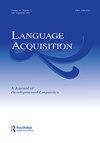Acquisition of empathy in child Japanese
IF 1.3
3区 文学
0 LANGUAGE & LINGUISTICS
引用次数: 1
Abstract
ABSTRACT This article investigates the acquisition of empathy verbs in child Japanese, focusing on verbs of giving/receiving: age-ru ‘give,’ kure-ru ‘give,’ and mora(w)-u ‘receive.’ These verbs are distinguished by which argument the speaker empathizes with when describing an event. For age-ru ‘give,’ the speaker empathizes with the subject (the giver); for kure-ru ‘give,’ the speaker empathizes with a non-subject (the recipient), and for mora(w)-u ‘receive,’ the speaker empathizes with the subject (the recipient). Using two diagnostics for empathy (alignment of first person with empathy loci; empathy loci being preferred antecedents in reflexive binding), 4- to 6-year-old children were tested. Our experiments show the following two findings: (i) children found kure-ru as most challenging, partially contradicting previous research; (ii) some children as young as age 4 have fully acquired the empathy-encoding properties of these verbs despite the speaker’s empathy being unobservable in the input. We discuss the challenges that kure-ru poses for children in light of the potential learnability problem that these empathy verbs pose.儿童日语的同理心习得
摘要本文调查了儿童日语中移情动词的习得情况,重点研究了给予/接受动词:age ru给予、kure ru给予和mora(w)-u接受这些动词的区别在于说话者在描述一个事件时会同情哪个论点。在“给予”年龄段,说话人对主体(给予者)感同身受;对于kure-ru的“给予”,说话人同情非主体(接受者),而对于mora(w)-u的“接受”,说话人移情主体(接收者)。使用两种移情诊断方法(第一人称与移情基因座的比对;移情基因座是反射性结合的首选前因),对4至6岁的儿童进行了测试。我们的实验显示了以下两个发现:(i)孩子们发现kure ru是最具挑战性的,部分与之前的研究相矛盾;(ii)一些4岁的儿童已经完全掌握了这些动词的移情编码特性,尽管在输入中无法观察到说话者的移情。我们讨论了kure ru给儿童带来的挑战,因为这些移情动词可能会带来学习问题。
本文章由计算机程序翻译,如有差异,请以英文原文为准。
求助全文
约1分钟内获得全文
求助全文
来源期刊

Language Acquisition
Multiple-
CiteScore
2.30
自引率
8.30%
发文量
20
期刊介绍:
The research published in Language Acquisition: A Journal of Developmental Linguistics makes a clear contribution to linguistic theory by increasing our understanding of how language is acquired. The journal focuses on the acquisition of syntax, semantics, phonology, and morphology, and considers theoretical, experimental, and computational perspectives. Coverage includes solutions to the logical problem of language acquisition, as it arises for particular grammatical proposals; discussion of acquisition data relevant to current linguistic questions; and perspectives derived from theory-driven studies of second language acquisition, language-impaired speakers, and other domains of cognition.
 求助内容:
求助内容: 应助结果提醒方式:
应助结果提醒方式:


